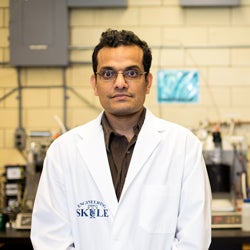U of T researchers grow micro-organisms that can clean tailings ponds and recover nickel

A new research partnership between U of T Engineering and companies in the mining sector uses micro-organisms to recover nickel from tailings ponds, like this one in Ontario (photo by Patrick Diep)
Published: April 20, 2023
Researchers from the University of Toronto – in collaboration with a group of mining firms – are using acid-loving bacteria to design new processes for recovering nickel, a critical mineral in growing demand around the world.
The research partnership with the Faculty of Applied Science & Engineering includes the following companies: Vale, Glencore, Metso-Outotec, BacTech, MIRARCO and Yakum Consulting. The insights gained could enable these companies to reduce their environmental footprint while at the same time gaining access to new sources of nickel, which is used in everything from stainless steel to next-generation batteries for electric vehicles.
Supported by $2 million in funding through Ontario Genomics from Genome Canada and another $2 million from the Government of Ontario, the industrial partners will also provide approximately $2 million in funding and in-kind contributions, bringing the total up to $6 million.

“Tailings from nickel mining operations have been an environmental challenge for a very long time,” says Radhakrishnan Mahadevan, a professor in the department of chemical engineering and applied chemistry who is leading the new partnership.
“If exposed to oxygen, chemical reactions in the tailings generate acids that makes them toxic to most forms of life. But we know that there are some microbes that can thrive in these environments. The biochemical techniques they use to survive can offer us new pathways to meet our goals.”
In Canada, nickel is found in ores that are mostly composed of iron and sulphur. After most of the nickel is extracted, the iron and sulphur remain, along with trace amounts of nickel – typically less than 1 per cent by weight. Together, these substances are known as tailings, and they exit the extraction process in the form of a slurry, a suspension of tiny mineral particles in water.
If the slurry is exposed to oxygen, the sulphur remaining in the slurry can become oxidized to form sulphate, a key component of sulphuric acid. To slow this process, the tailings are typically stored under water in tailings ponds. However, over time, these ponds still become highly acidic, with a pH in the range of 1-2.
Mahadevan, University Professor Elizabeth Edwards and Professor Vladimiros Papangelakis – all in the department of chemical engineering and applied chemistry – have been studying the organisms that are able to survive in these tailings ponds.
Several years ago, the team obtained samples from a mine tailings site operated by one of their industrial partners. By analyzing DNA present in this sample, they were able to identify a new strain of an organism known as Acidithiobacillus ferridurans. In 2020, they published the full genome of this new strain, which they called Acidithiobacillus ferridurans JAGS.
Ever since, the researchers have been further enhancing the capabilities of this bacterium through a process known as adaptive evolution. Samples that grow well in the presence of low concentrations of mine tailings are gradually exposed to increasingly higher concentrations. The best of those cultures are exposed to even higher concentrations, creating new strains that are more effective at carrying out key chemical reactions.
“This bacterial strain can actually extract energy from the oxidation of both iron and sulphur in a process that we call bio-leaching,” Mahadevan says.
“In the process, they also liberate the remaining nickel, which would otherwise be very difficult to recover from a solution this dilute. What’s amazing about the bacterium is that it can carry out these reactions at ambient temperatures and low pressures. And even more exciting is the idea that, if we understand how they are doing it, we might be able to control and direct the process.”
For example, the sulphur in the tailings is in the form of sulphide. Mahadevan says that instead of oxidizing it all the way to sulphate, which forms the acid, it might be possible to alter the process to instead create elemental sulphur. In this case, the sulphur would precipitate out of solution and could be sold as a commodity chemical for other applications, such as the production of fertilizers.
Mahadevan says the team will continue enhancing the bacterium through adaptive evolution, but that they are also pursuing a genetic engineering approach by using the emerging gene editing technique known as CRISPR.
“One of the things we’ve learned from studying this strain is that it has made more copies of certain genes that are involved in the transport of metal ions within the cell.
“If we use gene editing to further enhance the expression of these kinds of genes, we might be able to help it to grow even better, or to be more effective at carrying out the kinds of chemical transformations we want it to do,” Mahadevan says.
“Partnerships between the researchers and industry are the cornerstone of Ontario’s thriving innovation community,” says Bettina Hamelin, president and CEO of Ontario Genomics.
“By supporting the development and uptake of new technologies that provide game-changing solutions to the world’s most pressing challenges, Ontario Genomics is helping to nurture healthy people, a healthy economy and a healthy planet for generations to come.”
Mahadevan estimates that it will take another three to five years before the research team has both a bacterial strain and an associated process that will be ready to be tested in the field.
“Our goal with this project is to eliminate the technical bottlenecks to the application – to de-risk sufficiently so that our partners can put in the resources it would take to fully deploy it in their operations,” he says.
“If they can do that, it could not only completely change the way they deal with mine tailings, but also provide access to new sources of nickel – which will only become more important in the years to come.”



